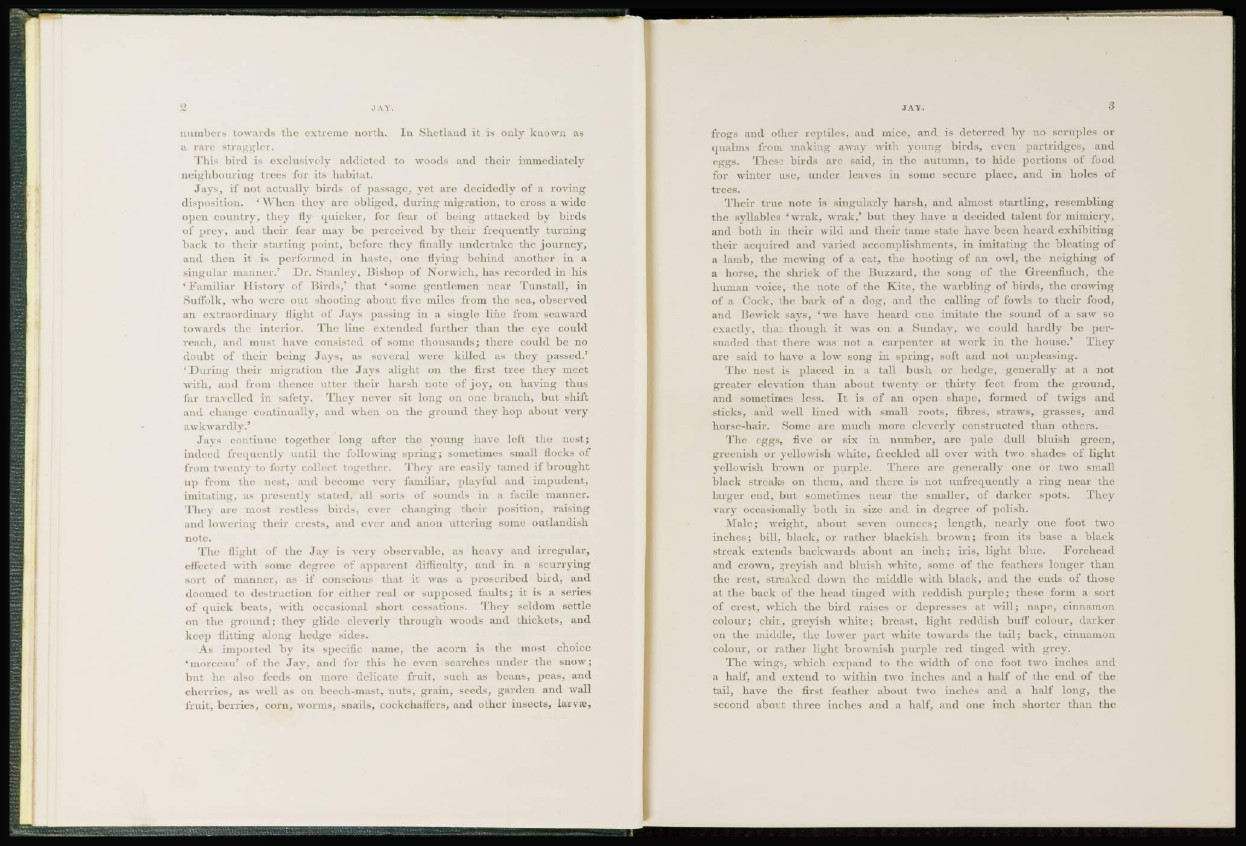
numbers towards the extreme north. In Shetland it is only known as
a rare straggler.
This bird is exclusively addicted to woods and their immediately
neighbouring trees for its habitat.
Jays, if not actually birds of passage, yet are decidedly of a roving
disposition. 'When they are obliged, during migration, to cross a wide
open country, they fly quicker, for fear of being attacked by birds
of prey, and their fear may be perceived by their frequently turning
back to their starting point, before they finally undertake the journey,
and then it is performed in haste, one flying behind another in a
singular manner.' Dr. Stanley, Bishop of Norwich, has recorded in his
'Familiar History of Birds,' that 'some gentlemen near Tunstall, in
Suffolk, who were out shooting about five miles from the sea, observed
an extraordinary tlighl oi Jays passing in a single line from seaward
i<>\\ ards the interior. The line extended further than the eye could
reach, and must have consisted of some thousands; there could be no
doubt of their being Jays, as several were killed as they passed.'
'During their migration the Jays alight on the first tree they meet
with, and from thence utter their harsh note of joy, on having thus
Jar travelled in safety. They never sit long on one branch, but shift
and change continually, and when on the ground they hop about very
awkwardly.'
Jays continue together long after the young have left the n e s t;
indeed frequently until the following spring; sometimes small flocks of
from twenty to fortv collect together. They are easily tamed if brought
up from the nest, and become very familiar, playful and impudent,
imitating, as presently stated, all sorts of sounds in a facile manner.
They are most restless birds, ever changing their position, raising
and lowering their crests, and ever and anon uttering some outlandish
note.
The flight of the Jay is very observable, as heavy and irregirlar,
effected with sonic degree of apparent difficulty, and in a scurrying
sort of manner, as if conscious that it was a proscribed bird, and
doomed to destruction for either real or supposed faults; it is a series
of quick beats, with occasional short cessations. They seldom settle
on the ground; they glide cleverly through woods and thickets, and
keep flitting along hedge sides.
As imported by its specific name, the acorn is the most choice
'morceau' of the Jay, and for this he even searches under the snow;
but he also feeds on more delicate fruit, such as beans, peas, and
cherries, as well as on beech-mast, nuts, grain, seeds, garden and wall
fruit, berries, corn, worms, snails, eockchaffers, and other insects, larvae,
frogs and other reptiles, and mice, and is deterred by no scruples or
qualms from making away with young birds, even partridges, and
eggs. These birds arc said, in the autumn, to hide portions oi' food
for winter use, under leaves in some secure place, and in holes of
trees.
Their true note is singularly harsh, and almost startling, resembling
the syllables 'wrak, wrak/ but they have a decided talent for mimicry,
and both in their wild and their tame state have been heard exhibiting
their acquired and varied accomplishments, in imitating the bleating of
a lamb, the mewing of a cat, the hooting of an owl, the neighing of
a horse, the shriek of the Buzzard, the song of the Greenfinch, the
human voice, the note of the Kite, the warbling of birds, the crowing
of a Cock, the bark of a dog, and the calling of fowls to their food,
and Bewick savs, 'we have heard one imitate the sound of a saw so
exactly, that though it was on a Sunday, we could hardly be persuaded
that there was not a carpenter at work in the house.' They
are said to have a low song in spring, soft and not unpleasing.
The nest is placed in a tall bush or hedge, generally at a not
greater elevation than about twenty or thirty feet from the ground,
and sometimes less. It is of an open shape, formed of twigs and
sticks, and well lined with small roots, fibres, straws, grasses, and
horse-hair. Some are much more cleverly constructed than others.
The eggs, five or six in number, are pale dull bluish green,
greenish or yellowish white, freckled all over with two shades of light
yellowish brown or purple. There are generally one or two small
black streaks on them, and there is not unfrequently a ring near the
larger end, but sometimes near the smaller, of darker spots. They
vary occasionally both in size and in degree of polish.
Male; weight, about seven ounces; length, nearly one foot two
inches; bill, black, or rather blackish brown; from its base a black
streak extends backwards about an inch; iris, light blue. Forehead
and crown, greyish and bluish white, some of the feathers longer than
the rest, streaked down the middle with black, and the ends of those
at the back of the head tinged with reddish purple; these form a sort
of crest, which the bird raises or depresses at will; nape, cinnamon
colour; chin, greyish white; breast, light reddish buff colour, darker
on the middle, the lower part white towards the tail; back, cinnamon
colour, or rather light brownish purple red tinged with grey.
The wings, which expand to the width of one foot two inches and
a half, and extend to within two inches and a half of the end of the
tail, have the first feather about two inches and a half long, the
second about three inches and a half, and one inch shorter than the